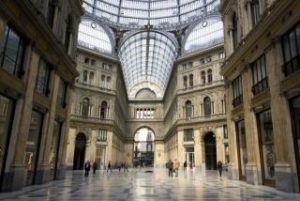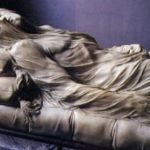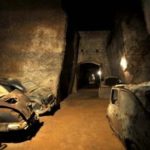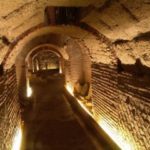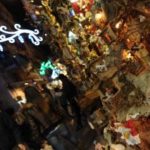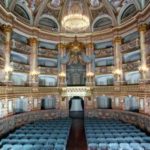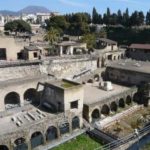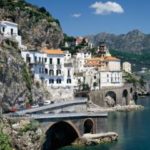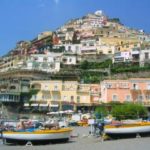Admiring the majesty of the Galleria Umberto I find it hard to believe that it was built in just 3 years. Begun in 1887 and completed in 1890, was built in the same year in which, in Paris, Gustave Eiffel realized his famous Eiffel Tower. The Galleria Umberto I had nothing to envy to the monument with which no rivaled in beauty and complexity of the structure.
The numbers of this building did turn his head: maximum length 147 meters, width 15, height 34 and a half, the apex of the dome of 57 meters. In a short time the Gallery became the center of “mundane” in Naples, thanks to its proximity to the most important places of the city.
All roads lead to Gallery
La Galleria Umberto I has 4 inputs: Via Toledo, Via Santa Brigida, Via San Carlo and Vico Broken San Carlo. The main entrance opens onto Via San Carloed consists of a semicircular façade and at the bottom is formed by a portico supported by columns of travertine and two blind arches, one enters the gallery and the other ambulatory. On the columns on either side of the arc on the left are represented in marble the four parts of the world. The first from the left symbolizes Europe and is a figure of a woman with her right hand a spear and relying on it, and guarding at the foot of a tombstone that read: Corpus Juris Civilis. The second figure holds a cup and represents Asia. The third has the facial features and clothing of Africa, is carrying a bunch of bananas and the left hand resting on top of a sphinx. The fourth is a female figure who could be considered “Colombian” for its clear allusion to geographical discoveries: his right hand rests on a fasces and the foot has a large volume of plates with a geographical globe on which is written Colombo , referring clearly to America. In the niches above it there are: left and right Physics Chemistry. The arch is positioned to the right of the observer is symmetrical to each other and the four columns that flank there are four statues representing the Winter, Spring, Summer and Fall. The seasons allude to the unfolding of time and the inevitable passing of life. In the niches there are overhanging the Genius of Science and Labour. At the end there is a marble group representing the Trade and Industry recline on the sides of Wealth. The author of these works is the Carrara Nicoli, sculptures and pupil of Giovanni Dupré.
Function commercial and monumental
La Galleria Umberto was raised in the city center so that there was a public space large enough and protected from the weather. The gallery was not only an important business and social function, but also monumental: could not look bad compared to the artistic beauty found in its vicinity as the Angevin, the Basilica of San Francesco di Paola, the San Carlo Theatre and the Royal Palace. In a short time in the Gallery focused shops, professional offices, editors of newspapers, offices and ateliers to become one of the places where the small and large events happening in the city of Naples.
La Belle Epoque at the Salone Margherita Neapolitan
In the gallery there were not only the commercial premises. A few steps from the Via Santa Brigida was built a small underground theater decreed to accommodate chamber concerts: Margaret Hall, which opened on November 15, 1890. After a few months the string quartet of the theater began to play the notes of the orchestra of frivolous and cheerful Variety and Margaret Hall indissolubly linked his name to the famous Neapolitan Belle époque. For more than twenty years this theater was the main seat entertainment night of the Neapolitans, not a cutout directly in the Galleria Umberto. To the temptations of this den of iniquity did not remain indifferent even the most brilliant minds of the time as Matilde Serao, Salvatore di Giacomo, Gabriele d’Annunzio, Roberto Bracco, Ferdinando Russo, Eduardo Scarfoglio and Francesco Crispi. On 16 May 1891 the then twenty-Vittorio Emanuele, Prince of Naples, was among the spectators who crowded theater. But Margaret Hall began its decline on the eve of the First World War due to competition from other theaters. During the two world wars the theater did nothing but live on memories without ever being able to reach once again the splendor of the past. During the War was home to vaudeville, then occasionally the “Song scripted” and then went to an inexorable decline of its former glory.
Artists around the Gallery of Naples
diurnal gallery goers were actors and orchestra musicians in search of contract. Always on the alert, sat at an outdoor cafe near the Salone Margherita or entertain themselves in groups waiting for a manager or a brother who wore the exciting news of the formation of a new theater company or an instrumental to be a part. Even today, those who spend the morning or late afternoon for the Gallery, you realize that right in the middle, where there is the floor with the drawings zoodiacali, meet and negotiate strange characters, especially managers of singers neomelodici or aspiring local artists.
The art of shine shoes
La Galleria Umberto I was for 50 years the kingdom of Shoeshine, shoeshine made famous by the film by Vittorio De Sica. The term is derived from “shoe-shine” (Shoe Shine) in the film are two boys from Naples who earn their living by shining shoes around, do not begin until a stunt for a path that leads them in jail and then more and more low. After the war, the Neapolitan Sciuscià had their headquarters first in the woods of Capodimonte and then in the Galleria Umberto, where for 50 years they have glazed shoes to customers. The chairs for the customers were veritable scarlet velvet thrones of a meter and a half high. Farsi shoes shined Gallery was a ritual, was part of the habits of the gentlemen chic, middle-class and everyone loved walking “shimmering”. Strangled rents and impossible from a tradition that has been dying then, the last two Sciuscià have closed their businesses a few years ago.
How to get to Galleria Umberto I
La Galleria Umberto I is located in the center of Naples is therefore a necessary step along all the itineraries of the city. Those arriving from Central Station to take the R2 bus stop (St. Charles). Those arriving from Capodichino must take the bus and get off at Piazza Municipio. Royal Palace is just a few hundred meters. The nearest metro station is Montesanto.



